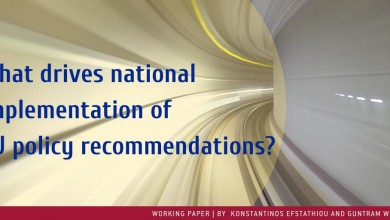Joint EU borrowing to boost the recovery, if not treated as national deficit and debt, will substantially ease rules-based fiscal adjustment needs in southern and eastern Europe, but not in western and northern Europe.
By now, the broad outlines of the European Union’s post-coronavirus recovery fund, Next Generation EU, are well known. Under NGEU, the European Commission will borrow up to €806 billion (current prices) and distribute it over six years to all EU countries. Most (€420 billion) will be distributed as grants while up to €386 billion could be distributed as credit. In addition, €90 billion (at current prices) in loans has already been granted to 18 EU countries from the temporary scheme, Support to mitigate Unemployment Risks in an Emergency (SURE), to help with the financing of short-time work schemes and similar measures.
But the impact of NGEU on the EU’s currently suspended fiscal rules has been barely discussed. How will these substantial transfers be accounted for in the EU’s fiscal framework and what are the implications for the fiscal stance? Though a debate on the future of the EU fiscal rules is underway (for example, whether the rules should be replaced by standards, or completely redefined), these questions have so far been neglected.
Accounting for NGEU grants and loans at EU level only?
The Bundesbank December 2020 Monthly Report called for EU debt to be counted towards national debt and deficits, similarly to the debts arising from the European Financial Stability Facility (EFSF), which are attributed to EU countries. There are good reasons, however, why this should not be done, and we understand that Eurostat and the European Commission do not plan to allocate the EU debt and deficit to national debts and deficits. The main reason for this is that such an allocation would be extremely difficult, or even impossible: the repayment of EU debt cannot be clearly allocated to any national treasury. It is impossible to make reasonable estimates of how much each EU country would contribute to the repayment of the EU debt, starting from 2027 and running to 2058, related to the financing of NGEU grants, partly because it depends on many unknown future developments such as relative GNI developments in EU countries in the next four decades. Moreover, some of the money for repayment is supposed to be raised from newly created EU taxes, such as the unrecycled plastics tax. Allocating a ‘federal’ debt to national budgets would make that debt de-facto national debt. While the underlying taxpayers obviously are all EU tax subjects, the character of NGEU debt is clearly very different to national debt.
Loans granted by NGEU to member states have the specific characteristic that the borrower country is obliged to repay that in full, even if the underlying borrowing is guaranteed by EU countries and the EU budget. Thus, NGEU loans should contribute to headline national public debt and deficit numbers. However, if spending financed by such loans does not benefit from special treatment in the EU fiscal framework, borrower countries will have to reduce their non-NGEU spending once the currently suspended fiscal rules are re-activated. A simple way to avoid this is to treat all NGEU-financed expenditure as one-off and exclude it from the structural balance (headline budget balance adjusted by the impact of the economic cycle and one-off expenditure and revenue measures), because fiscal adjustment under the EU rules is defined by the change in the structural balance. Similar treatment is needed to assess compliance with the expenditure benchmark.
EU fiscal rules and NGEU
So how would these grants to national budgets, assuming they do not count towards national deficits and debts, change the budget positions of countries, and what will be the interplay with the fiscal rules? EU rules limit public debt and budget deficits in various ways. If the budget deficit is larger than 3% of GDP, or public debt is more than 60% of GDP and does not decline by the 1/20th of the gap relative to the 60% threshold, the deficit is considered excessive and an excessive deficit procedure (EDP) aims to force the reduction of the deficit. The minimum annual fiscal adjustment is a 0.5% GDP improvement in the structural balance under the EDP.
Breaching the 1/20th debt reduction rule will probably be as inconsequential as it has been up to now: an EDP has never been initiated for a breach of this rule because of various exemptions, which could be taken into account again. But even if the 1/20th rule were used to initiate an EDP, the subsequent fiscal adjustment will be at least 0.5% of GDP annually. The actual fiscal adjustment decided by the Council of the EU can be less than what could be needed to meet the 1/20th rule.
When the budget deficit is below 3% of GDP and public debt is below 60% of GDP, or public debt is higher but is reduced by the 1/20th rule, the deficit is not considered excessive and preventative measures apply. In this case, the structural balance should be above the country-specific medium-term objective (MTO). If this is not the case, fiscal consolidation is needed. The benchmark adjustment is an annual 0.5% GDP improvement in the structural balance, but the requirement can be higher or lower depending on the level of public debt and the value of the output gap (see the table on page 17 of the EU fiscal rules Vade Mecum). When the structural balance is lower than the MTO, the rate of public expenditure growth should be below the medium-term potential economic growth rate.
If EU debt resulting from NGEU is not counted as national debt, the corresponding national spending financed by EU debt will not count as deficit either. In turn, such national spending will not be part of the structural deficit and public expenditure indicator, and thus could offset the fiscal consolidation of the non-NGEU component of the national budget.
How does NGEU change fiscal trajectories if EU fiscal rules are reapplied?
If the EU’s fiscal rules remain unchanged and if they are reactivated in 2022 or 2023, several EU countries will likely be placed in an EDP. Among the six largest EU countries, the Commission foresees budget deficits over 6% of GDP in France, Italy and Spain in 2022, suggesting that the deficit will not fall below the 3% threshold in 2023 and perhaps not in some subsequent years (Table 1)[1].
Table 2 and Figure 1 show that NGEU can materially reduce the pressure from the fiscal rules in 2022-2024 for France, Italy and Spain. While the structural deficit (not considering NGEU spending) would have to be improved by at least 0.5% per year, this fiscal tightening would be largely offset by the ‘one-off’ transfer from the NGEU. In fact, in 2022, while in France the NGEU would compensate for half of the necessary adjustment, in Spain and Italy, the transfer would be larger than the adjustment necessitated by the rules.
The fiscal outlooks for Germany, the Netherlands and Poland suggest that preventive measures would apply, but the estimated structural balances of these countries will fall below their MTOs, necessitating fiscal consolidation of about 0.5% of GDP annually.
Poland’s fiscal adjustment under the rules would be more than compensated for by NGEU transfers, but this would not be the case for the Netherlands and Germany. In addition, the reinstatement of the German debt brake would further increase the necessary fiscal consolidation in Germany.
Figure 1: European Commission structural balance estimates (2003-2022) and our projections for 2023-2026, with and without NGEU
[infogram id=”1pe2z53gmd1jn3am00jjqplyk9sljxvw7g7″]
Three important lessons
First, NGEU grants will have a substantial impact on the EU’s fiscal stance if they are not accounted for in national deficits and the EU’s fiscal rules. Their impact will be 0.38% of EU GDP for 2022, 0.66% for 2023 and 0.74% for 2024. NGEU loans, if fully utilised, would lead to approximately 0.6% of additional EU GDP spending each year. ECOFIN and Eurostat should urgently clarify the treatment of NGEU-financed expenditures under the EU fiscal rules. Such a clarification would be helpful to boost the EU economy in the coming years and would contribute to more accommodative fiscal policy.
Second, NGEU grants and loans will substantially reduce budget consolidation pressures arising from the EU fiscal framework in Italy, Spain, Poland and France from 2022 to 2024. After 2024, as transfers fall substantially, the fiscal adjustment needs would become substantially greater.
Third, the large net-payer countries into NGEU, including Germany and the Netherlands, will have substantially larger fiscal adjustment needs under the EU fiscal rules. Germany’s needs will be even greater once its debt brake is applied. At the same time, NGEU transfers are comparatively small.
It is beyond the scope of this blog post to evaluate whether the resulting overall fiscal stance of the EU will be too tight or to too loose in the coming years (and there are good reasons to argue that the EU’s overall fiscal stance in 2021 is too tight). However, somewhat counterintuitively, we suggest that the rules-induced fiscal adjustment problem may be smaller than thought in central and southern European countries, but substantially larger than thought in the Netherlands and Germany, thanks to NGEU. This suggests that Germany in particular should increase its fiscal stimulus during 2021 and 2022 to support the recovery and help the European Central Bank in closing the output gap. That should go hand in hand with higher inflation rates in Germany than in the rest of the EU.
The bottom line is that NGEU, if accounted for outside of national debts and deficits, is a meaningful way of supporting the EU’s fiscal stance. If it becomes a permanent feature of the EU’s architecture, it would help with the recovery phase when fiscal rules start to constrain national fiscal policymaking. Moreover, it is an instrument to support the EU’s major investment needs.
[infogram id=”1p2n2d9qqkx7xqi0vldzww9je9tr0mpk6de”]
Recommended citation:
Darvas Z. and G. Wolff (2021), ‘The EU’s fiscal stance, its recovery fund, and how they relate to the fiscal rules’, Bruegel Blog, 4 March
[1] The COVID-19 pandemic is clearly an exceptional and temporary event that has increased budget deficits throughout the world. But the EU Treaty only allows such events to be taken into account in not opening an EDP if the deficit remains close to the reference value, which is unlikely for France, Italy and Spain in 2022-2023.


